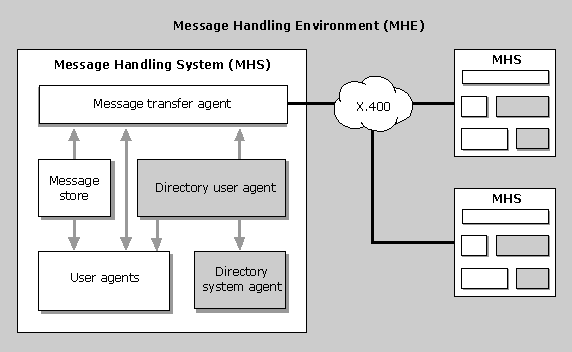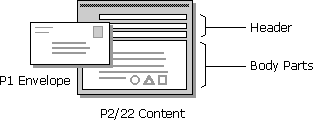
| Concepts and Planning | << | >> |
|---|
The X.400 Recommendations define the standards of an electronic messaging system and enables users to exchange messages regardless of the system.
The X.400 Recommendations were developed by an organization known as the Comité Consultatif International Télégraphique et Téléphonic (CCITT). The CCITT publishes recommendations every four years. Each publication is identified by a color:
The Electronic Messaging Association (EMA), which includes private e-mail software development companies, develops specifications for e-mail software development. The EMA publishes standards that further define the X.400 Recommendations.
The X.400 Recommendations are based on the Open Systems Interconnection (OSI) reference model defined by the International Organization for Standardization (ISO). The X.400 Recommendations specify the structure of a message handling system, message structure and components, and the method used to transfer messages. Microsoft Exchange Server complies with the 1984 and 1988 X.400 Recommendations.
The OSI reference model provides a layered architecture that standardizes the method computers use to exchange information through a communications network. The OSI model separates computer-to-computer communications into seven layers: application, presentation, session, transport, network, data link, and physical. The top three layers usually relate to the operating system and applications that run on it. The other layers determine the way networks interconnect.
The following diagram illustrates the seven OSI layers and examples of the protocols and standards that are used in each layer:

Using the OSI model, an administrator can choose the physical network, the protocols and transports transmitted over the network, and the software and hardware used on each end of the connection. As long as each layer receives and transmits information correctly to the layers above and below, it doesn't matter what combination of hardware and software is used in each layer.
X.400 runs on the application layer of the OSI model. This enables application processes to access network services. X.400 represents services that support user applications, such as software for file transfers, database access, and e-mail.
An X.400 message handling system (MHS) is a collection of components that work together to transfer messages. The X.400 Recommendations specify that an MHS should have the following components.
| Component | Description |
|---|---|
| User agent (UA) | Prepares, submits, and receives messages for a user. Displays messages and provides other functions, such as text editing and security. |
| MTA | Forwards and relays messages within the network. |
| Message transfer system (MTS) | Two or more MTAs. |
| Message store (MS) | Stores messages transferred between MTAs and user agents (1988 Recommendations only). Known as the information store in Microsoft Exchange Server. |
| Access unit (AU) | Gateway to other messaging systems. |
The set of message handling system components and users is called a message handling environment (MHE). An MHE can include several messaging systems connected through gateways or public data networks, or just one message handling system where messages are contained within the system.
An X.400 MHS usually works with directory services, including the directory user agent and directory system agent. Directory services are not part of the X.400 Recommendations, but the 1988 X.400 Recommendations allow the use of directory services. The directory is a database of all objects in the message handling system, such as mailboxes and distribution lists.
The following diagram illustrates how the components of the MHS work together to transfer messages:

The user agents and message transfer agents in the MHS form the message transfer system (MTS) and the interpersonal messaging service (IPMS).
The MTS is a collection of one or more MTAs that submit, transfer, and deliver messages through the MHS. The MTS is the infrastructure of message handling.
In the following example, a user agent submits a message to the MTA within the MTS for delivery to one or more MTS users. The MTS accepts the message and provides any necessary store and forward features, such as distributing the message to more than one recipient. The MTA then routes and delivers the message.

The IPMS enables messages to be exchanged from person to person. When a message is sent from one user to another, the IPMS invokes the services of the underlying MTS to submit and deliver the message to its destination.
The following illustration shows how the MTS functions within the IPMS:

There are two types of IPMS messages: interpersonal messages and interpersonal message notifications. Interpersonal messages contain text, graphics, or other content sent from one user to another. Interpersonal message notifications contain information about the status of the delivery of the message, or whether the message was read or not read.
Messages are transferred through the MHS by protocols defined in the X.400 Recommendations. The protocol for each message component is assigned a number. The following are the most common protocols:
| Component | Protocol |
|---|---|
| Envelope | P1 |
| Message content (1984) | P2 |
| Client-MTA communications | P3 |
| Client-message store | P7 |
| Message content (1988) | P22 |
An X.400 message has two components: an envelope and its content.

The envelope contains addressing information, including the address of the originator and recipient, the delivery priority, and message trace information. The envelope is formatted by using the P1 protocol.
Most X.400 messages are made up of one or more body parts, together with header information. The body parts make up the text of the message. The header contains address, routing, and trace information, and determines how the message is transported.
The X.400 body contains the actual message, which can include text, graphics, sound, or other kinds of data. The X.400 Recommendations specify standards for different types of content in body parts. Body parts are referred to by body part numbers.
The following table shows the X.400 body part types and numbers that can be used with Microsoft Exchange Server:
| Body Part Type | Body Part Number | Description |
|---|---|---|
| IA5 text | BP 0 | International alphabet number 5. Includes U.S. English, German, Norwegian, and Swedish. |
| Teletex 61 | BP 5 | U.S. English teletex. |
| Forwarded interpersonal message | BP 9 | Embedded and forwarded messages. |
| ISO 6937 text | BP 13 | Eastern Europe and German characters. |
|
Bilaterally defined (binary) |
BP 14 | Simple transfer of binary attachments. |
|
Binary file transfer (file transfer body part [FTBP]) |
BP 15 FTBP | Transfer of attachments using FTBP, which includes file name, size, and properties. Available for MTA conformance modes only. |
| ISO 8859-1 |
Encapsulated within BP 15 |
Latin 1 code page. Available for MTA conformance modes only. |
The header fields contain information such as the message originator, recipients, and expiration time, which is useful for tracing messages and troubleshooting. Microsoft Exchange Server uses the following header fields:
| Field | Description |
|---|---|
| originator | Originator/recipient (O/R) address of originator. |
| authorizing-users | O/R addresses of send on behalf of. |
| primary-recipients | Recipients specified on the To line. |
| copy-recipients | Recipients specified on Cc line. |
| blind-copy-recipients | Recipients specified on Bcc line. |
| expiry-time | Message is deleted if it is not read by the specified time. |
| deferred-delivery-time | Message is sent at the specified time. |
| subject | Up to 128 characters (truncated from up to 255 characters). Sent using Teletex T.61. |
| importance | Low, medium, or high. |
| sensitivity | Low, medium, or high. |